|
FAQs on Butterflyfish Infectious Diseases
FAQs on Butterflyfish Disease:
Butterflyfish Disease 1,
Butterflyfish Disease 2,
Angels and Butterflyfishes &Crypt,
FAQs on Butterflyfish Disease by Category:
Diagnosis,
Environmental,
Nutritional,
Social,
Trauma,
Parasitic,
Treatments
Related Articles:
Butterflyfishes,
Related FAQs:
Butterflyfish,
Butterflyfish Identification,
Butterflyfish Systems,
Butterflyfish Foods/Feeding/Nutrition, Butterflyfish Compatibility,
Butterflyfish Behavior,
Butterflyfish Selection,
Butterflyfish Reproduction,
|
A few diseases are associated with this symptom, mainly
infectious (septicemic, bacterial, internal). Boosting the animal's
immune system by food supplementation, improving water quality are
important steps here.
|
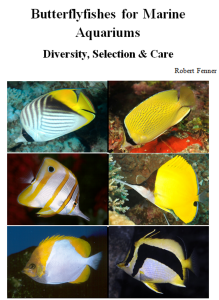 |
Butterflyfishes for Marine
Aquariums
Diversity, Selection & Care
New eBook on Amazon: Available
here
New Print Book on Create Space: Available
here
by Robert (Bob) Fenner |
|
Re: Quarantine question
9/15/16
I have a Threadfin Butterflyfish that looks like it is hemorrhaging and some
of the scales seem to be separating.
<Mmm, I see this>
Attached is a picture. It is especially evident near the dorsal fin and down
the side of the fish. Any idea what this might be?
<Yes; this fish is classically "breaking down"... can't tell exactly from
what from the pic (need more information re the recent past... system,
handling... AND sampling and microscopic exam to be sure re ext. parasitic
involvement. HAVE seen Uronema, Cryptocaryon... Mycobacteria almost
always.... w/ such fishes. I would tell you that w/o immediate action (I'd
lower spg drastically; like to 1.010) this fish will soon perish. I WOULD
remove it, or all other fishes from the same system. There are blitzkrieg
type treatments... that attempt to treat all likely pathogens... A poor
avenue to take.... Do you have time to study, NOW? Bob Fenner>
Ciao,
Steve
|
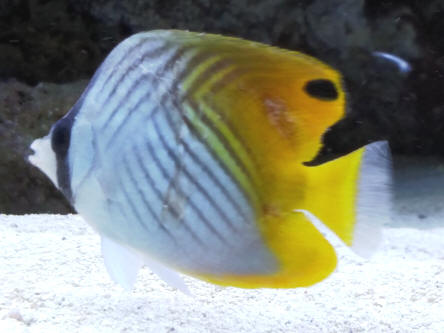 |
|
Re: Quarantine question. Auriga BF
9/16/16
Hi Mr. Fenner,
<Hey Stephen!>
Thank you for the input and analysis. Unfortunately, the fish perished
yesterday. All of the other fish appear to be healthy - eating very
well, behaving normally.
<Ahh; yes to the early demise of the BF. As prev. stated, DO KEEP AN EYE on your
other fish livestock. It may well be that they will be similarly stricken....
and COULD perish in likely soon order>
As you can see from the email string, I have had unbelievable challenges trying
to get the last two fish in my main tank. I was trying to get a Yellow
Long-nosed Butterfly fish and the Threadfin. Per your advise, we had been
bypassing the QT and doing a freshwater dip and placing them in the main tank. I
have lost two sets of each of these fish with this Threadfin being the last -
having survived for 41 days. I purposely chose these two fish because everything
I read said they are the easiest Butterfly fish to keep. I am now ready to throw
in the towel on trying to add these two fish to my aquarium.
<I'd look to other families of fishes>
I currently have the following in the 220 gallon tank: 3 orange Ocellaris
Clownfish, 2 Black Ocellaris Clownfish, Flame Hawkfish, Tailspot Wrasse, Yellow
Tang, Hepatus Tang, Blond Naso Tang, and a Coral Beauty. I would like to add two
more fish. Do you think this size tank will accommodate two more?
<Yes I do>
All of the fish I have are small except the Blond Naso Tang which is about 7".
If you think I have room, I was thinking about adding a Blue Throat Triggerfish
and a Royal Gramma. What are your thoughts?
<These are good choices. >
Thank you as always.
Ciao,
Steve
<And you; Bob Fenner>
Re: Quarantine question 9/16/16
Thank you!
Ciao,
Steve DeFilippis
<Certainly welcome. BobF>
|
|
re: Forceps butterfly spot
3/26/16
Ph range 8.1
Ammonia 0ppm
Nitrite 0ppm
Nitrate 0ppm
Salinity .022
PraziPro and copper as well as Kent marine Zoe Vit and minerals Started out
as unnoticeable spot/bump and now looks like large bruise.
Seems to be growing in size and color.
<Kody, fielding this because it's not clear to me you got Bob's message.
He's off on a coral reef somewhere in the ocean, and his access to the
Internet is equivalent to dial-up, and sending a 4MB image (PNG format, to
boot!) isn't going to help him to help you. So for now, let's direct you to
some reading, here:
http://www.wetwebmedia.com/forcipdisfaqs.htm
To my admittedly untrained eye this looks like an opportunistic infection,
perhaps started by physical damage (rough handing for example, or
interspecific aggression) but basically something that is precisely what you
suggest, a bruise gone bad. Although Forcipiger are fairly adaptable fish
(by Chaetodontid standards, anyway) they are still quite demanding,
especially with regard to their need for a varied diet rich in vitamins (the
fact they'll eat all sorts of things doesn't mean they get all the nutrients
they need, any more than the fact cats drink milk means it's good for them).
So let me direct you to some more reading, here:
http://www.wetwebmedia.com/forcipig.htm
http://www.wetwebmedia.com/forcipsysfaqs.htm
http://www.wetwebmedia.com/forcipfdgfaqs.htm
All else being equal, if you optimise living conditions, remove sources of
stress, and ensure the right diet and vitamin supplements, this little chap
should recover under his own steam. In my opinion, over/mis-medicating
Chaetodontids causes more problems than it cures, so best holding off the
medications unless you're 100% sure there's a good reason to do so. Cheers,
Neale.>
|
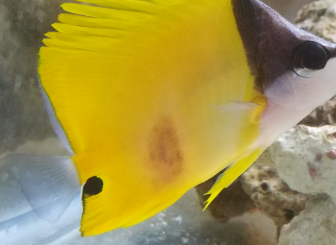 |
Miliaris #1 & #2
3/6/16
Greetings,
<Salud>
I've been attempting to keep C. miliaris and the first died in qt after
10 weeks from what I thought was an internal bacterial infection -
bloat, constipation, stopped eating and died. Attempted to treat
with Kanamycin and used Epsom salts for constipation.
<Mmm; this is a fave B/F; Hawaiian endemic>
I ordered yet another and reduced the overall time spent in qt to 8
weeks, here we are at 9.5 wks and the fish has looked quite good in the
display, but now is displaying similar symptoms to the first:
minor bloat, constipation, enlarged anus which looks frayed, still
eating, a bit reclusive. I stopped feeding and the constipation
improved, but it left his anus large and damaged. I'm thinking of
leaving him in the display with hope his own defenses can take care of
the perceived infection.
My question is whether this is common for this species and if it is
likely tied to the shared qt both used?
<These sorts of losses are (too) common for Chaetodontids period. I am
not a fan of quarantining, isolating any member of the family (and
a few others). Better to expedite... dip/bath new specimens, and plunk
them into established displays directly>
Are internal bacterial infections contagious?
<Mmm; not really... there is some more issue w/ hyper-infective states,
but it is the pre-disposing conditions: stress, starvation, ammonia
burn.... a myriad of other factors; that tip the balance between health
and disease>
I think I will sanitize the qt, but am concerned for the other fish in
the display.
Sincerely,
Sarah
<Do read here:
http://www.wetwebmedia.com/mardisease.htm
and as much of the linked materials at top till you feel you have a good
grasp.... Bob Fenner>
Re: Miliaris #1 & #2 3/7/16
Thank you, this was knowledge I needed...I'm assuming you're referring
to a formalin dip?
<Mmm; possibly.... please read here: ....
I've used it successfully to treat flukes (2 wks in hospital tank with
dosage from bottle), but each fish developed a post treatment condition
seemingly related to a suppressed immune system. For ex. the female
percula's colors faded and the Butterflyfish and tang continually
developed small infections whereas
beforehand they were all long-time seemingly healthy inhabitants, all
which died within the next year. Perhaps a dip would not have this
side-effect? Or are there other recommended meds such as Acriflavine?
<Here:
http://www.wetwebmedia.com/dips_baths.htm
and the linked files at top>
Btw, the miliaris is demonstrating improvement with the infection, I'm
continuing very small 3x/day feedings and optimal water quality.
<Good>
Sincerely,
Sarah
<BobF>
Chelmon Lymphocystis
4/8/15
Hey Bob, I've had a CBB in a 55 qt for about 6 days now. After nipping at live
rock for 2 days he finally started eating vitamin soaked PE mysis.
He's been eating about 6-8 shrimp a day and is active. It did have a
little "lymph" when I got it, but has gotten worse since.
<Quite common; and I would expedite this (and all Butterflyfishes) through
quarantine... likely do a preventative dip/bath and place straight away. NOT to
worry re the Lymph... easily defeated, not often spread...>
The water quality is great; 1.022 SG,
<Mmm; would keep more NSW, 1.025-6>
ammonia and nitrites at 0, nitrates at about 20 and it is the only fish in the
tank. There is plenty of LR plus I'm running a Fluval 406 with ceramic media
seeded from my main sump. I've been reading about possibly transferring
him to the DT, but am nervous.
<Don't be>
It's only been 6 days, so it could still have ich theoretically, also the lymph
will eventually explode and possibly spread.?
<No... see, READ on WWM re>
My 150g DT inhabitants are as follows... Black dogface puffer (7"), teardrop
butterfly (4"), comet (6"), Flagtail Blanquillo (7"), orange tail filefish (4"),
and a long nosed hawk (3").
The DT is extremely healthy and active and has been for about 2 years.
Do you think I should be patient here, or risk transferring him.
<I would definitely do the latter>
Another worry of mine is that he'll have a lot of competition for food and may
perish unless I keep him where he is to "fatten him up a bit".
Especially the file fish who is the fastest most voracious eater I've ever seen
:) Any thoughts? Thanks!
-Jay
<Welcome. Bob Fenner>
|
Urgent! Please Help!
Heni, BF hlth... secondary infectious 7/5/14
Dear Bob, et al.
<Karen>
A friend of mine has had severe issues in his 150 gallon, FOWLR,
tank. Fish inhabitants included mature emperor, juvenile emperor, mature
Koran, juvenile gray, juvenile queen, niger trigger, pink tail trigger,
powder blue, Heniochus and Pakistani butterfly. (in retrospect
overstocked and the system just couldn’t handle it).
<Aye yi yi... needs more than twice this space...>
Initially he had removed all liverock and media from tank to treat the
system for ICH. He treated with CopperSafe for six weeks and then
another six weeks roughly to get the copper out with water changes.
During this time, the Pakistani butterfly showed signs of illness, he
stopped eating and died about a week later. I thought I could see a
slight film on this fish but we didn’t think anything more about this
(perhaps our mistake).
<Well; am just finishing up an e- and direct to print book on BFs, so,
am brushed on my Butterflyfish diseases! This Heni is way overstressed,
by the crowded conditions, likely bullying by the Angels, Trigger...
likely environmental issues like high NO3... and the copper exposure...
Triple whammy!>
About three weeks after the Pakistani butterfly died, all the other fish
appeared well and with confidence my friend was about to put the live
rock and sand back into the system. He first put the sand in and almost
immediately, perhaps from irritation from the sand (so we thought) the
fish started flashing, scratching and shaking their heads. My friend
removed the sand the next morning thinking it was the sand. The fish
continued to show irritation for a few days and that’s when he decided
to treat with the CopperSafe again, thinking that there was still some
bug that had survived somehow. After two weeks of treating with the
CopperSafe, there was absolutely no improvement, in fact the condition
deteriorated; fish began opening their gill plates and struggling to
breath. He asked me to come over and give my opinion. I felt that it was
a very urgent matter and that it was probably a bacterial/fungal type
infection and that the water was toxic. We tested for ammonia, nitrite
and both were negative. I felt that the fish should be moved to a
hospital tank with clean water and treated but at that point there were
too many fish to move and no place to put them.
<Oh yes; agreed>
We changed large volumes of water and aerated the tank and added
Metroplex at the advisement of the LFS.
<Mmm... very hard on (challenged already) fish's kidneys...>
Fish started dying, first the powder blue, then mature emperor, the pink
tail trigger, the Koran; all other fish were affected and at death’s
door.
<Yes; the med.>
In desperation, I set up a 75 gallon hospital tank at my house. (I have
2 tanks 220 and 120 with large sumps and I was able to utilize the water
from these tanks to help with the situation). We added Furan 2 and
Methylene blue (in case it was a fungus).
<Plus good as an oxygen-carrier and reducer of stress by providing
shade>
Remaining fish improved almost immediately however we lost the juvenile
emperor during this treatment period and the Heniochus was questionable
for a few days; I thought we were going to lose him but he recovered.
My issue today is regarding the Heniochus; he has a new issue,
black/grayish areas that seem to be under the scales. At first I though
it was bruising or scarring from the previous bacterial episode, but
these markings are getting bigger every day. Should I retreat this fish?
Any suggestions about what I should use to treat him? I am very
concerned that it could be mycobacteriosis? Probably not. He’s still
breathing normally and eating as are the rest of the fish.
<Mmm; tough call... I would likely NOT treat this BF... just hope it
recovers spontaneously given good conditions and nutrition>
I have attached 2 pictures, sorry one is blurry. but that’s pretty much
how it looks.
Sorry for the extensive details but there was a lot going on that lead
up to this final problem with this fish.
Thank you so much for you input,
Karen.
<Thank you for sharing. Oh! Do take a look on WWM. Have split up the BF
dis. FAQs into their usual 8 sub-cat.s
Bob Fenner>
|
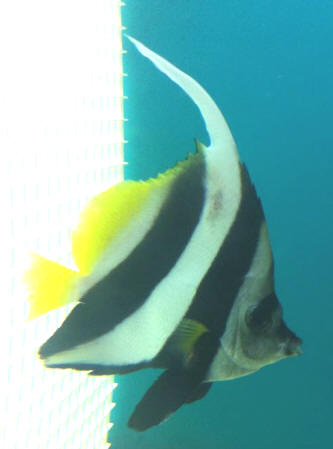
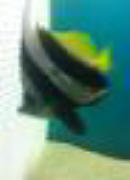 |
|
Re: Urgent! Please Help!
7/5/14
Thank you for your prompt response!
I have been watching and waiting to see if it gets better. It's been
about 3 days now since I noticed it and every day it gets bigger. I'm
just afraid it could be another bacterial infection under the scales. As
you said, it's a tough call. This fish has already been through so much
and I really don't want to lose him. He pulled through the first bout
and now this. I'll wait and see for now. If he stops eating again or it
spreads any more, what is the best antibiotic that would penetrate the
skin and go directly to the infected area?
<Please read here: http://wetwebmedia.com/BFInfectDisF.htm
Thanks again Bob, very much appreciated.
Karen.
<Welcome Kar. BobF>
RE: Urgent! Please Help!
7/6/14
Hi Bob, Sadly, I woke up early this morning and found the Heniochus
dead. I had decided to leave him be yesterday and see if he could fight
it off himself as he was still eating and he was in excellent quality
water. He seemed off though. He wasn't swimming around, only when the
food was offered into the tank but he was taking it.
<Mmm>
After taking the dead fish out of the tank I inspected him closely and
those dark marks were actually bleeding and again had spread even more
over night. He appeared to have just recently died when I found him.
How disheartening, to bring a fish back from death's door and have to
watch him go through that door a week later from a secondary infection.
<Yes>
I'm surprised that the fish developed this infection after being in
Furan 2 for 5 days; he almost immediately started displaying those marks
which spread each day over 3 days and then dead. I doubt that the
outcome would have been any different had I chose to treat him with
anything else. He was just too weak from the whole ordeal. Who knows?
<Even with sampling, culture, sensitivity testing... indeed>
And to know just what to treat him with? It's a guessing game.
<It is in almost all cases... In future I fully suspect that some sort
of "Star Trek" "tri-corder" like device/s will instantaneously recognize
antigens, other protein properties... perhaps ahead of "doom time" to
alert one as to impending issues>
The Furan 2
<Which/I would have advised a Furan compound...>
helped with one infection but he still developed the secondary one and
it overtook him so quickly.
I just wanted to let you know the outcome, as sad as it is. I really
wanted to see him pull through.
Thanks again for your support and advice.
Karen.
<Thank you for your compassion, sharing. Bob Fenner>
|
|
Chelmon Muelleri with likely infection
12/16/13
Greetings,
<Sarah>
I have a well established 120 gal reef system, in Aug I introduced flukes
via snails and had an epidemic. My Chelmon Muelleri survived and has
been the only fish in the tank (was reintroduced Oct 26th) since the others
weren't as fortunate.
<I see>
After the fluke infestation was treated I've been battling secondary
infections with this fish, all were healed when suddenly he's developed a
rather large bump (~3/8") behind and above his eye. There is slight
underlying redness and seems slightly irritated. My question is does
this warrant erythromycin in food for 10 days or would it be wise to simply
observe?
<I think so. Unfortunately "what it takes" to actually sample, culture and
test for resistance/efficacy in the way of anti-microbials isn't "worth the
damage" here (in my perception, experience of course)>
I've attached two pictures from when the lights are out, strangely that's
when I get the best pictures-you can see the redness and the bulge.
Sincerely,
Sarah Hlavenka
<I would instead seek to boost immunity, recovery via optimized, stable
conditions and improved nutrition (HUFA, vitamin soaking of foods). Bob
Fenner>
|
.JPG)
.jpg) |
Re: Chelmon Muelleri with likely infection
12/16/13
Basically he said treat with optimal water conditions, fatty acid and immune
system supplements.
<Ah yes. BobF> |
|
Re: acclimatization; Mmm, sand use in QT sys., BF dis f's
7/1/13
Hello my Mentor. :)
<Hola Tomasz!>
Regarding the sand I was concerned about whether to keep the fish in
tanks shop with sand or without it, how is better. Ok invalid.
<With sand is better unless the water, fish is being treated with
chemical/s that absorb it too much>
In Annex I send photo, if you could see and write what kind of
disease (bacteria / parasites). Is it contagious? if so, how to treat
other fish?
How to prevent.
<Looks like this Klein's Butterfly has been consumed by some sort of
flesh eating bacteria. But such infections are almost always secondary;
caused by primary challenges of the environment, some lack of nutrition,
bullying, luminal worm, external parasite issue/s... The bacteria only
jumping in number, pathogenicity due to weakening of the fish/food
consequently.
Please read here re:
http://www.wetwebmedia.com/mardisease.htm
I installed on my system ozone. At this time, ORP is 270mV, I understand
that it would be best as that was 400mV?
<Yes; between 325 and 400 mV>
Thanks again for help Bob.
Tom
<Ah welcome. Bob Fenner>
|
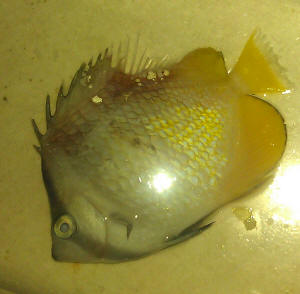 |
| about a weird thing grow on the fish...
Crap English, dead plebeius... 3/9/08 hi again
today I've noticed 1 of the fish has something grow on the
right side of his body. I think it maybe a decease... But every
other fishes are ok, and the Singapore angel. let's take a look
at the attached pic. He seem to not eating, and almost these 2 days
seen him on top of the water, and breathing hard.... Is there any
chance to safe him? He's acting normal most of the time when
light was on. Peter <... you're joking? This fish is dead...
See WWM re BF Disease, Systems... Maybe Pathogenic Marine
Diseases... Sheesh, is there a full moon? Bob Fenner!> |
|
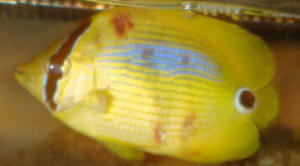 Hey dude, you're dead! Hey dude, you're dead!
|
Swollen Long Nose Butterfly
7/19/06 Hello Ladies and Gentlemen, <Tamara> I have struck a
bit of a problem with my long nose butterfly. He has become quite
"swollen" (the best way of describing it) around the top and
bottom sections of his body. I have searched your site and have found
nothing on this, only swelling around the eyes and mouth (which my fish
does not have). <Yikes... the condition is/can be termed
"Ascites", bloat... dropsical... many causes... some more
primary than others... but something causing fluid to leave cells,
tissues... and occupy intracellular space, body cavities...> I took
the fish, with minimal stress, to my fish shop after they said they
have never heard of such thing and would need to see it. Consequently
he put me on to your website. They do have an enormous amount of
experience but said they have never seen anything like it and will look
into it themselves further also. Looking from behind; say the fish is
3mm in width; where it is swollen at the top and bottom, it is more
like in excess of 10mm wide - like someone has pumped it full of air!
It is still feeding and active - apart from the "swelling" it
is behaving fine. Any reply would be greatly appreciated as I am rather
concerned. Thank you. Regards Andrew Brown Melbourne Australia. <It
may be that there is a "simple" bacterial involvement here
(from?) that can be thwarted with the application of one/some form of
antimicrobial/antibiotic. If this were a very valuable fish or a bunch
of them, I would avail myself of injectable material (Chloramphenicol
succinate would be my first choice)... For home/hobbyist purposes, it
may be that a water-administered product is best... a Furan compound:
http://www.wetwebmedia.com/antibiofaqs.htm
and a search on WWM with the name. If this/these are not available
locally or easily, do look into what you can get in the way of a
gram-negative, broad-spectrum antibiotic... administer at 250 mg. per
actual ten gallons of water... change a good part of the water out and
replace, re-treat every three days for three treatments... Not in the
main/display system... Bob Fenner>
Re: Swollen Long Nose
Butterfly 7/22/06 Hi Bob, <Tamara> Thank you so
much for your reply. My fish shop said your site, and your staff, would
be extremely helpful and he was 100% correct. I will track down a
antimicrobial/antibiotic today. Just for my own knowledge, will this,
or can this affect the other fish in the tank; or is fish specific
(i.e.. is it contagious and should expect more fish to become this
way?) <Not able to say, but generally such involvements are
"not catching"> Secondly, was there a way of preventing
this, or is it just a pure random occurrence? Thanks so much. Tamara
<Mostly the latter. One can do their best to provide optimized,
stable conditions, good nutrition... and still have such incidents. Bob
Fenner>
Longnose butterfly My Longnose butterfly has developed a dull
red streak along its spine. <Not good> It is internal (not a
surface scratch) as it is only visible when viewed from the side when
the fish is swimming at the front of the tank i.e.. with light from
behind. I added a piece of artificial coral the day
before, which I have since removed after noticing the redness on the
butterfly. <Do you think the coral affected your water
chemistry?> I have fifteen other fish in my 200 gal, all
look fine. The butterfly is active and eating
well. <Ah, good> Could it be a toxic reaction from
picking at the artificial coral? <Maybe, but doubtful... if the
coral was made for aquarium use... and your other livestock show no
symptoms> Are there any diseases that produce this
symptom? Please advise. Thanks, Peter <A few diseases are
associated with this symptom, mainly infectious (septicemic, bacterial,
internal). Boosting the animal's immune system by food
supplementation, improving water quality are important steps here. Bob
Fenner>
Double Saddle Butterfly May I direct this question to Bob
Fenner as I read something he wrote on butterflies : <Okay> I
found this poor DSB BF at Petco (a nationwide retailer) He had what I
call cotton ball disease on his tail , mouth and fin. Not to mention
his mouth area is red. <A sad situation> I have already been
through one round of Spectrogram and two rounds of Maracyn. I bought
him knowing full well his condition because he would have most
certainly died in their store. I took him from not eating to eating and
picking at stuff in the HT. <Great> However the Cotton ball stuff
is not falling off and his mouth area is still red. He breathes a
teensy bit more rapidly than I would like but otherwise seems good. I
keep his water quality as high as I can. I found yesterday that his PH
was way too low so I am correcting that. <Takes time> Could that
be the reason the meds are not working as well as they should?
<Possibly> Otherwise his water is great. I test it
every other day. I am not giving up on this little guy. He greets me
every morning and seems to look to me for hope. <Good> Can you
impart any advice or procedures other than what I am doing? <Mmm,
considering the improvement evidenced thus far, I would keep on doing
what you're doing. Soaking foods in a vitamin and HUFA mix (like
Selcon) might speed on feeding, improvement in overall health> He is
in a ten gallon HT with a heater and airstone. Should I put a filter on
the back? (Penguin etc) <Yes, I would> Someone told me he will
clear up as soon as he is put into our reef aquarium. Well : <This
is very likely so> 1. Our new 55 gallon reef upgrade is still
cycling. <Wait then> (We have a 30 Gallon FO) right now. 2. I am
scared of what he might bring with him to a brand new reef system.
<Not a problem in this case... difficulties from poor treatment,
handling ahead of your acquisition... not likely a real
"infectious or parasitic disease"> Bob, thank you for any
advice you can give. Sincerely, Christy Evans <Press on my friend,
and do keep us informed. Bob Fenner>
Boo-Boo On A Butterfly? Dear Bob <Actually, Scott F.
today> My raccoon BF seems to have a bacteria infection, he have
some red lesion, kind of like sore.. the fish have large scale as you
know, and the red sore seems to be spreading, it had 2 places of
infection, and now spread to 3.The BF seems fine and eating well. the
spot I observe is under the scale, kind of like swollen, how do I know
what it is?? How do I know it is a bacteria infection or not??
<Well, it's hard to be 100 percent certain from here, but the
fact that it's spreading may be indicative of some form of
infection. The origin of the infection may have been an injury or other
trauma to the body of the fish.> If so, how should I treat him?? Or
should I treat him ?? Thanks Eric <Well, Eric- I'd observe this
fish for a few more days to see if this "condition" spreads
more. Maintain top-notch water quality to avoid additional infection.
If the fish does not show any improvement, or appears to be declining,
I'd move the fish to a separate "hospital" aquarium for
treatment with an antibiotic, such as Maracyn...With good water
quality, keen observation, and rapid intervention should it become
necessary, you'll see this make a full recovery soon! Hang in
there! Regards, Scott F>
Problem with my Pearl scale butterfly... Robert I have a
Pearl Scale Butterfly that I got about 3 weeks ago. When I got him I
bought a Cleaner Wrasse as the Butterfly had ick the week before and
the pet store had placed the Wrasse in with him. I had reservations
about keeping a Wrasse as I've read they will starve to death in
captivity, however, mine seems to love Daphnia and frozen Brine Shrimp
and has a healthy appetite. <Ah, good> I freshwater dipped both
fish when I brought them home to avoid getting a healthy dose of ick in
my fish only tank (although, so far they are the only fish in there).
They were both fine afterwards but for the last week, I have noticed a
swelling and some pink coloring at the base of the Butterfly's
right Pectoral fin to the point where he can't fold it back against
his body. as of yesterday, it's getting a dark red place on the
surface of the skin at that site and I also noticed a couple scales on
his opposite side about midway down his side are pushed out although
very slightly. Is it possible he has some kind of internal parasite? If
so, How could I identify it and more importantly, how should I treat
it?? <Possible... or perhaps "just" a bacterial problem...
and not good. The appearance you characterize can be real trouble, a
"breakdown" contagion of mainly marine Butterflyfishes...
let's hope this one resolves on its own... in the trade some folks
will bathe a whole tank or individuals in Furacyn compounds, some try
adding gram-negative broad spectrum antibiotics to the animals foods
(if they're eating).> I appreciate any help you could provide.
Thanks very much for your time. <Wish I could tell you more.
Bassleer's book, Noga's newest efforts are about as helpful in
this situation unfortunately. Bob Fenner> Mike
Re: Problem with my Pearl scale butterfly... Thanks for your
reply Bob. Since I heard from you I bought some Furacyn and a Broad
Spectrum Gram Negative Antibiotic (I put it in the water as he
won't eat since I've moved him to the hosp. tank) and have been
treating the butterfly with it. The place at his pectoral fin and under
his scale have opened and are showing raw tissue now. <A typical
scenario...> I dipped him out and coated both places with Iodine as
I had heard a friend had treated her fish who had an open wound with it
at the pet store's recommendation. I figured it couldn't hurt
at this point. <A good idea, yes> Anyway, I just wanted to thank
you for the information. <You're welcome my friend. I wish you
and you B/F well. Bob Fenner> Mike
 |
Butterflyfishes for Marine
Aquariums
Diversity, Selection & Care
New eBook on Amazon: Available
here
New Print Book on Create Space: Available
here
by Robert (Bob) Fenner |
|
|

